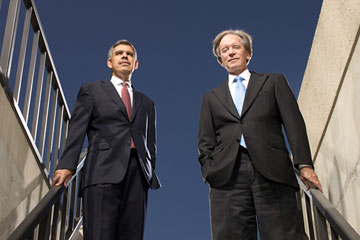
PIMCO's Mohamed El-Erian and Bill Gross.
(4 of 6)
Much of PIMCO's good fortune over the past several years is due to Gross's canny trader instincts, which he honed at blackjack tables in Las Vegas after college. (A stamp collector and yoga enthusiast who grew up in the Midwest, he studied psychology at Duke and has an M.B.A. from the Anderson School of Management at UCLA.) But a good chunk may also come from El-Erian's sophisticated worldview. The son of an Egyptian diplomat, El-Erian grew up in places like New York City, Paris, Geneva and Cairo, was educated at Oxford and Cambridge and eventually became a deputy director at the IMF before taking over PIMCO's emerging-market bond fund from 1999 to 2005. He then left briefly to run Harvard's endowment fund, to mixed reviews, and returned to PIMCO at the end of 2007. As a developing-world specialist, he's seen a debt crisis or two--which is one of the reasons he was less likely to buy into the idea that highly leveraged institutions selling spliced and diced securities was simply the next evolution of capitalism, as did many at the time. "We never believed the bull----, basically," says El-Erian. "We never believed that finance can just exist [separate from the real economy]."
Both Gross and El-Erian nurture contrarian views. Many PIMCO staffers are given training in behavioral economics to better understand their biases about people, culture and finance and how they might be influencing their decisionmaking. That's perhaps in part why PIMCO was quick to see, post-2008, the passing of an era. Things that once seemed unthinkable--the U.S. flirting with default, unlimited central-bank money dumps--were suddenly happening. While most experts (including those within the Obama Administration) were plotting how to move from recession back to the trend growth rate of 3% or 4%, PIMCO was grappling with the idea that 2% growth might be the new normal not for a couple of years but for decades.
Welcome to the New Normal
By 2009, Gross and El-Erian had come up with their seminal paper on the new normal, which has become a catchphrase for describing our current reality of painful deleveraging, polarized politics and a slow-growth, bifurcated economy in which multinational corporations and plutocrats flourish but everyone else struggles. In his most recent investment note, issued at the end of October, Gross makes the very sharp point that while consumer spending, stock prices and housing have been goosed by the Fed, we're still not saving and investing as a society. Consumers may have saved a bit more postcrisis, but the U.S. net national savings rate--government, household and corporate savings left after depreciating assets are taken out of the equation--is still hovering just below zero. That's lower than at any other point since the Great Depression. "Surely by now, if the Bernanke model was as advertised, we would be seeing a ... willingness to start saving seed corn as opposed to eating caramel corn," writes Gross.
